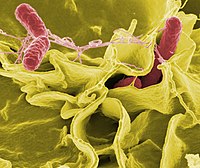
Photo from wikipedia
Blood stream infections and invasive non-typhoidal Salmonellosis in particular remains a major health and economic burden worldwide. The complexity of blood matrices along with extremely low concentration of pathogens in… Click to show full abstract
Blood stream infections and invasive non-typhoidal Salmonellosis in particular remains a major health and economic burden worldwide. The complexity of blood matrices along with extremely low concentration of pathogens in blood pose great challenge for rapid and ultra-sensitive detection. Sample preparation has been the critical step that should provide blood matrix free sample with the targeted pathogen in the highest possible concentration. In this work, we addressed this challenge by combining magnetic bead based pathogen concentration and Solid-phase PCR (SP-PCR). The SP-PCR performed on a super critical angle fluorescence (SAF) microlens array embedded in a microchip enabled quick and accurate detection of low levels of Salmonella enterica serovar Typhimurium and Enteritidis in blood samples without culture enrichment. Protein AG-magnetic beads immobilized with anti-salmonella antibody could efficiently concentrate both Salmonella serovars with a capturing efficiency >95%. Higher tolerance of Phusion hot start DNA polymerase to PCR inhibitors and its compatibility with protein AG-magnetic beads allowed the integration of SP-PCR. Analysis of Salmonella spiked blood samples with the SP-PCR resulted in a limit of detection (LoD) as low as 86 CFU/mL and 94 CFU/mL for S. Typhimurium and S. Enteritidis respectively that could be attributed to the high fluorescence collection efficiency of the SAF microlens array. These combinations reduced the duration of analysis to less than 3 hours including sample preparation. This platform has the potential for its wide application as a high-throughput biosensor to analyze pathogens in clinical, food and environmental samples.
Journal Title: Analytical chemistry
Year Published: 2020
Link to full text (if available)
Share on Social Media: Sign Up to like & get
recommendations!